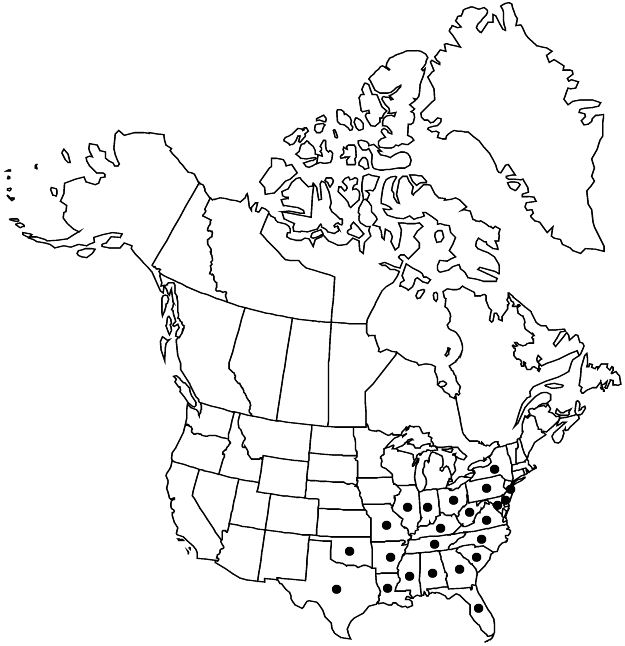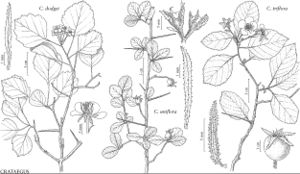Crataegus uniflora
Hausvater 5: 147. 1770.
Shrubs, 10–20 (–50) dm. Stems: twigs: new growth densely appressed-pubescent, 1-year old brown, older grayish; thorns on twigs usually numerous, sometimes absent, ± straight, 1-year old black, needlelike, 3–5 (–8) cm; young thorns soft, rapidly growing, needle-pointed shoots with linear bracts, often curved initially, straightening. Leaves: petiole very short or absent, pubescent, glandular or not; blade narrowly elliptic, elliptic, obtrullate, spatulate, oblanceolate, or narrowly rhombic-elliptic, sometimes suborbiculate, (1–) 1.5–3 (–6) cm, length/width = 1.5 or narrower, base cuneate, lobes 0, margins crenate to serrate, teeth variably caducous, black eglandular or gland-tipped, venation semicamptodromous to camptodromous, veins 3 or 4 (or 5) per side, ± impressed, apex obtuse to broadly acute, often somewhat glossy, abaxial surface sparsely to moderately pubescent, veins ± densely pubescent, adaxial densely scabrous, especially young. Inflorescences 1–3 (–5) -flowered; branches pubescent; bracteoles of two types: ± persistent, green, herbaceous, margins serrate, teeth glandular, or caducous, linear, membranous to herbaceous, margins glandular. Flowers 10–15 mm diam.; hypanthium strongly tomentose, (sometimes bearing a caducous, linear, membranous to herbaceous, gland-margined bracteole); sepals foliaceous, usually longer than petals, 2–4 mm wide, surfaces sparsely pubescent; anthers white to cream; styles 5. Pomes yellowish to ruddy, 8–10 (–12) mm diam., ± tomentose; flesh firm, dry, or mealy; sepals persistent, patent, 7 mm; pyrenes 4 or 5.2n = 51, 68.
Phenology: Flowering Apr–May; fruiting Sep–Oct.
Habitat: Sand barrens, sandhills, open scrubby woodlands, often associated with Pinus clausa, P. palustris, P. rigida and xerophytic species of Quercus and Carya
Elevation: 10–200 m
Distribution

Ala., Ark., Del., Fla., Ga., Ill., Ind., Ky., La., Md., Miss., Mo., N.J., N.Y., N.C., Ohio, Okla., Pa., S.C., Tenn., Tex., Va., W.Va., Mexico (Tamaulipas)
Discussion
Crataegus uniflora is widespread in the southeastern United States from Long Island (New York) to eastern Texas; it is most abundant in the coastal plain and lower piedmont. A disjunction in the Mississippi embayment between trans-Mississippian and cis-Mississipian populations mirrors a similar pattern in C. spathulata (J. B. Phipps 1998).
Crataegus uniflora is usually easy to identify because of its small size, leaves small and coriaceous with lobes absent, numerous straight, fine thorns, inflorescences uniflorous or few-flowered, sepals glandular-pectinate and equal to or longer than the petals, anthers white to cream, and pomes yellowish to ruddy. Possible confusion with some members of ser. Lacrimatae is treated under the series discussion. Sterile plants might be confused with small, sterile ones of C. berberifolia (ser. Crus-galli) except for the smaller number of lateral veins on the leaves. An interesting feature of C. uniflora is the occasional deep lobing of extension-shoot leaves, even narrow ones, with veins to sinuses.
Crataegus uniflora is somewhat variable in plant size, leaf shape, number of flowers to an inflorescence (though commonly one), and anther color (usually ivory to cream). The typical form, which is common, has 1- or 2-flowered inflorescences, and is usually a small shrub with more or less spatulate to narrowly obovate leaves. Some particularly dwarf forms of this, on laterite soil in Georgia, have been observed with over 100 flowers when less than 3 dm.
Forms of Crataegus uniflora with 3–6-flowered inflorescences are also common and are represented by C. parvifolia and C. trianthophora. These are connected to the typical uniflorous kind by numerous intermediates and may be distinguished from the related C. brittonii by their smaller and narrower leaves with lobes absent.
Three anomalous variants, very similar or identical to Crataegus uniflora except for possessing small, more or less unlobed but glandular-serrate sepals, are known. These are: C. croomiana Sargent from northern Florida, C. bisulcata Ashe from North Carolina, and C. grossiserrata Ashe from Florida. The first, also best known, is further distinguished by pink anthers, the second by broader leaves, and the third by often orbiculate (unusual for ser. Parvifoliae) extension-shoot leaves with a tendency to deep lobing sometimes with veins to sinuses, and particularly strong and sharp leaf teeth. All suggest hybrid origin with ser. Lacrimatae.
Selected References
None.
Lower Taxa
"thin" is not a number."adnate" is not a number."dm" is not declared as a valid unit of measurement for this property.
